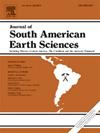Probability of sub-hourly extreme precipitation events in Recife, Brazil
IF 1.5
4区 地球科学
Q3 GEOSCIENCES, MULTIDISCIPLINARY
引用次数: 0
Abstract
This study investigates the probability of sub-daily extreme precipitation events in Recife; a city located on the eastern coast of Brazil. Using hourly rainfall data from the National Institute of Meteorology (INMET) station between 2005 and 2021, the frequency and intensity of these events were estimated through the Generalized Extreme Value (GEV) distribution. To contextualize the impacts, disaster records from the National Center for Monitoring and Early Warning of Natural Disasters (Cemaden) for the period 2016–2021 and journalistic reports (2005–2021) were integrated. The results highlight strong seasonality: the March–May (MAM) and June–August (JJA) periods concentrate the most intense events, with rainfall exceeding 30 mm/h showing more than 70 % probability in MAM, and events greater than 40 mm/3h with over 60 % probability. The association between extreme event occurrence and the higher frequency of disasters underscores Recife's urban vulnerability. The findings provide practical support for the development of public policies, including improvements in early warning systems, drainage planning, and hydrometeorological risk management. The coincidence of these extremes with disaster peaks further reinforces the city's vulnerability.
巴西累西腓次小时极端降水事件的概率
本文研究了累西腓亚日极端降水事件的发生概率;位于巴西东海岸的一座城市。利用2005年至2021年间国家气象研究所(INMET)站的每小时降雨量数据,通过广义极值(GEV)分布估计了这些事件的频率和强度。为了了解这些影响的背景,我们整合了国家自然灾害监测预警中心(Cemaden) 2016-2021年期间的灾害记录和2005-2021年的新闻报道。结果表明:3 - 5月(MAM)和6 - 8月(JJA)时段降水强度最大,MAM时段降水超过30 mm/h的概率超过70%,大于40 mm/h的概率超过60%。极端事件的发生与灾害频发之间的联系凸显了累西腓城市的脆弱性。研究结果为公共政策的制定提供了实际支持,包括改进早期预警系统、排水规划和水文气象风险管理。这些极端事件与灾难高峰的巧合进一步加剧了这座城市的脆弱性。
本文章由计算机程序翻译,如有差异,请以英文原文为准。
求助全文
约1分钟内获得全文
求助全文
来源期刊

Journal of South American Earth Sciences
地学-地球科学综合
CiteScore
3.70
自引率
22.20%
发文量
364
审稿时长
6-12 weeks
期刊介绍:
Papers must have a regional appeal and should present work of more than local significance. Research papers dealing with the regional geology of South American cratons and mobile belts, within the following research fields:
-Economic geology, metallogenesis and hydrocarbon genesis and reservoirs.
-Geophysics, geochemistry, volcanology, igneous and metamorphic petrology.
-Tectonics, neo- and seismotectonics and geodynamic modeling.
-Geomorphology, geological hazards, environmental geology, climate change in America and Antarctica, and soil research.
-Stratigraphy, sedimentology, structure and basin evolution.
-Paleontology, paleoecology, paleoclimatology and Quaternary geology.
New developments in already established regional projects and new initiatives dealing with the geology of the continent will be summarized and presented on a regular basis. Short notes, discussions, book reviews and conference and workshop reports will also be included when relevant.
 求助内容:
求助内容: 应助结果提醒方式:
应助结果提醒方式:


